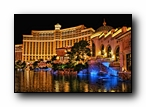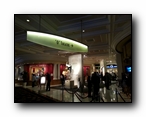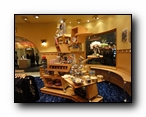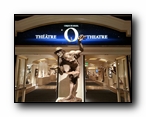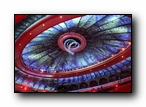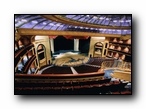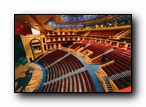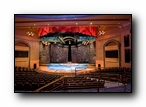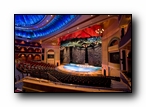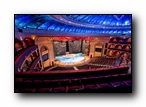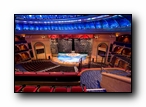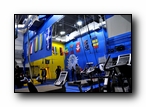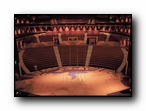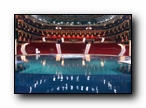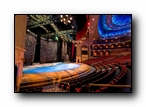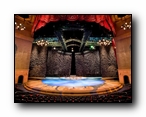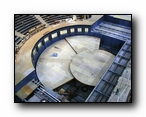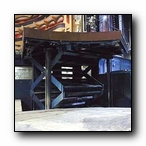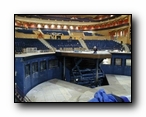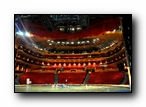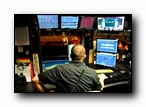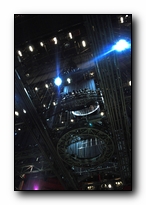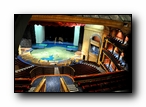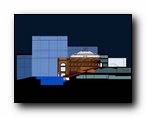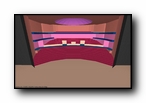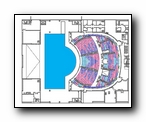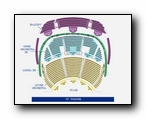
![]()

[ You are here: Grand Chapiteau | Creations | «O» | Scénographie ]
Création
Expérience
RetiréOdyssey
"O", a phonetic play on the French word for water - "eau", is a baroque world filled with disturbing images, impressive acrobatics and amazing technical intent. The theater built for the show, Cirque's first (and at present only) aquatic show, is also a revolutionary conceptual space. Designed and created by Cirque du Soleil, Scéno Plus, and Atlandia Design over a 2 1/2 year period (February 1996 to July 1998), the 1,800 seat theater reflects the style of a 14th century European opera house with arched loges and warm gold, red, and blue tones. Reportedly costing $70 million US to build, it sports a number of innovative theatrical constructs making the space the first of its kind. Nearly 500 people had devoted over 400,000 man-hours to the preproduction and production phases of the show alone, not counting the time spent on the construction of the theatre. And very prop and costume had to prove its resistance to the harshness of a liquid environment. This is one instance where it is hard to separate the theatre design from the production itself, as the success of both revolves around the pool.
You'll find the Bellagio theater tucked away in a seemingly normal looking hallway on the casino floor, but nothing can prepare you for what you'll see inside. The interior of the theatre was designed by Michel Crête of Cirque du Soleil in collaboration with architect Michel Aube of Scéno Plus, a Montreal-based firm, and it's a marvel of innovation masked by exquisite beauty and detail.
Take for example the Cupola, or rounded ceiling vault. At some point your eyes will dart the 12-stories skyward and you'll find a breathtaking ceiling washed in turquoise, indigo and blue. Take another glance... underneath that beauty lies an innovate framework of galvanized metal mesh with a trellis (or frame of latticework) that allows for an infinite array of lighting effects to be used. Cirque uses this space to place scores of different colored lights to not only light the theater but also the stage below. The translucent look is achieved with two layers of galvanized metal mesh lit from behind with GAM 725 (turquoise), GAM 890 (deep indigo) and Lee 161 (steel blue) gels with over 4000 MR16 zip strips and 192 Altman PAR-64s. The result is a kinetic shimmer above the audience, with one layer of the mesh pulled taut and the second layer hand-crunched according to Crete's specifications. The Cupola also comes with a space used for overhead performances, which is utilized at the beginning of the show. A trapeze artist bathed in fog and light, with cyan (Lee 116) and indigo (GAM 890) gel in the followspots as specified by lighting designer Luc Lafortune, descends from a chandelier, or curved aluminum truss structure to open the show. Fisher Technical Services of Las Vegas designed and constructed a special braking system for the chandelier, as well a custom flying winch, which moves the performer up and down in sync with the raising and lowering of the chandelier. While the ceiling itself is a wonder to behold, how many of you have sat with mouths agape as the curtain is drawn back into the depths of the theater for the show's explosive beginning? If so, you're not alone. The curtain impresses many who have seen the show. So, how does it work? That amazing feat is done by another winch by Fisher that draws back at a speed of 14-feet per second! At that velocity one would imagine the curtain would flutter noticeably. But believe it or not, Cirque keeps the curtain from fluttering with a series of weights that hold it in place timed to release with the curtain's upward motion. This keeps the curtain taught throughout the entire drawback sequence. The curtain itself is nylon, approximately 50 feet high by 100 feet wide, and light in weight. To the casual observer's eye, however, it looks like luxurious velvet because "it's lit exquisitely." Two ropes from the winch attach to the curtain (which is really two pieces) at the center. When the signal is given the winch starts pulling, the hooks at the top of the stage release, and the curtain (and audience) is swept away. The curtain is pulled up smoothly onto a large roller. The custom-built winch that pulls the curtain resides high in the grid rigging over the stage. Weighing around 500 pounds and about 5 1/2 feet in height, its 8-foot winding drum (with high sides to take up the curtain) acts as a big sewing spool, powered by a 20-horsepower SEW EuroDrive induction motor mounted vertically. Once activated by a technician holding a joystick touch screen, it takes just 6 seconds for the curtain to be whisked away completely. This curtain is pulled up to reveal yet another curtain that floats on top of the pool and is pulled aside to reveal the water. The winch used is a Fisher 20-horsepower F200 model that draws back at a speed of 14-feet per second. It moves away to reveal another innovation of the theater, the pool itself. (At the end of the show, a similar red curtain is used, but this one appears magically from a wicker basket that seems to float on the water. The curtain is pulled quickly into a closed position by a system of wires and traveling guides.) Fifty-five feet above the stage and the pool is the Téléphérique, a complicated system of trusses and catwalks with automated winches and tracks that support performers, scenery, and props. Conceived by Crete and Johnny Boivin (of Cirque's production staff) and engineered by Olaf Soot Associates (a sub-contractor to Hoffend & Sons who installed the rigging), the téléphérique consists of 6 tracks of box truss with open bottoms and catwalks on top, each of which contains two independent traveler winches that can move scenery and acrobatic devices up and down, or from side to side (for a total of 24 winches. Four of these are 70-feet long and run parallel to the proscenium. The other two measure 130-feet long and run upstage to downstage, and are placed 26-feet apart to support the central carousel. The 18 ton, 24-foot diameter Carousel travels on the inside of the upstage/downstage tracks. It is driven by a continuous loop cable drive that can spin up to 180 feet per minute (3 feet per second). It is supported by four double-wheel trucks, designed to equalize the loads on the polyurethane-treaded wheels. It's four winches can lift up to 1,000 pounds each at speeds of up to 240 feet per minute (4 feet per second) at 2 RPMs. Lighting on the carousel includes four ETC Source Fours and 16 Par-64s, operated without DMX cables, using wireless method by Radio DMX technology on the 2.4GHz band. The carousel sits 55' above the stage. Additional rigging exists 100 feet in the air on the high grid which includes 41 scenery-related winches. The winches used to fly the performers have a maximum line pull of 1000 lbs at a maximum velocity of 15 feet per second with a 2G acceleration. A number of scenic elements - props, if you will - make use of the téléphérique throughout the show. A carousel of horses, for instance, lower from the rafters during the opening sequences. The four horses (ridden by Comets) are made of Fiberglass, run on battery power, and are equipped with propellers. The horses are controlled by two levers; the clutch has three forward speeds and one reverse. Each horse weighs 750 pounds (340 kilograms). Another prop, one that created one of the biggest development headaches, was the mirror that rises from the water on center stage. It had to be capable of a complex range of motion, including a 90-degree pivot, before rising vertically into a one-meter slot in the ceiling.
To translate his vision into reality, Crete designed a vegetation curtain, or "Vege," which resembles a swamp-like maze of plant roots and serves as a backdrop for many of the show's acts. Made of vapor-resistant, rigid plastic, the "Vege" curtain was made by thermoforming, a process in which Lexan is poured into a 45-foot x 60-foot mold and left to solidify, at which point paint and varnish are applied. To create visual contrast with the dark "Vege," Crete added two white rip-stop nylon curtains that look like sails and pivot from points on the grid. These were designed to add an airiness that does not get soggy when wet, especially in scenes with rain and mist. The pool itself, also designed by Crête in conjunction with Scéno Plus, is 25-feet deep and measures 150-feet from right-to-left by 100-feet from upstage-to-downstage. While the pool itself is an interesting marvel, haven't you ever wondered how it all becomes a stage? Below that liquid surface lies a series of hydraulic lifts built specifically by Handling Specialty of Grimsby, Ontario. There are seven of these lifts, consisting of four primaries and three auxiliaries, each with a one-million pound capacity holding up the 53x90 foot main stage surface. Each platform these lifts support measures 1,000sq feet and can quietly travel (thanks to special sonic probes) from a depth of 17-feet 3-inches below water level to 18-inches above, moving separately or together at a rate between 5 and 25 feet per minute. Each lift is powered by three hydraulic rams, each with a 100,000 pound weight capacity, and use in its hydraulics a biodegradable vegetable oil. The rubber floor of the lifts is custom-designed and fitted with a resilient rubber-like material (fiberglass combined with sports matting with PVC) in a series of 4-foot by 8-foot panels. Each panel contains 5,000 plus holes to allow water to pass as the stage is raised or lowered. But the speed of their disappearance and sudden reappearance can fool you into thinking that the lifts and the stage are quite light. In fact, the combined weight of the system is a hefty 460,000 pounds! 10 months of research went into the creation of the surface. But the lifts are only part of the innovation. Many of the problems with the show's development came because of the water itself. Ask yourself a couple of questions: How would the noise of the splashes be contained? How could the temperatures between the water and the air be comfortable for both the performers and the patrons? How could the smell of chorine be contained? How could a stage of water be lit without reflection? How would the performers hear the music to make their cues? How to keep costumes from disintegrating from the pool's chemicals? And how would they breathe? The solutions are novel in their own right. The undesirable noise of waves splashing against the sides of the pool is absorbed by a series of different sized pebbles scattered around the ring (or gutter) of the pool. These rocks, used in conjunction with special matting from 3M called Nomad, help absorb the waves, and thereby the noise. Another problem is masking activity. An aquatic masking system that makes the pool form and bubble is created by more than one mile (6,000 feet) of perforated hose, mounted on the bottom of the pool. The perforations allow bubbles to form, which serve to mask any underwater activity. A team of 14 divers also works every show. Not only do they help the acrobats make their mark, but they're also there in case of an emergency. You'll only see them once - and that's a scripted point in the show! Because the large pool of water has to be kept warm and is rather humid (the temperature in and around the water is approximately 87 degrees), a special HVAC system was developed by Cirque and Scéno Plus in conjunction with Dupras & Ledoux of Montreal to provide air-conditioned comfort for the audience. A temperature of 72 degrees is maintained in the seating area by way of a special ventilation system with silent air movement that brings cool air at 55 degrees directly under each seat. Special air cannons can be used to warm the air around the stage and control the movement of the ventilation. The mesh ceiling acts as a chimney and allows the warm air to escape the auditorium. Using Bromide in the water averts the chlorine smell. Lighting and Sound are issues in their own right. Water and electricity are not considered very good bedfellows. In fact, one usually conducts the other to all kinds of nasty behavior. And how DO you project audible sound under the water? But Cirque du Soleil and Scéno Plus have found a way to marry the two with fantastic results here. Read on.
Working with a cast of 74 performers, 115 technicians, 1.5 million gallons of water, and 1,815 lighting instruments (using more than four million total watts of light), it might seem like a contradiction in terms for Luc Lafortune to say that his lighting for "O" is simple. But his clean yet expressive lighting gestures, with bold dichroic colors cutting through fog and mist or dancing on the water, adds a beautifully restrained elegance to a 90-minute spectacular performed in, on, around, and above a giant swimming pool. "Simple" is of course a relative term. There is nothing simple about the complicated ground-fault dimming system created for the pool, or the infrastructure for the entire lighting system, which has a cutting-edge crispness unmatched at this time. "O" provided an aquatic canvas full of movement, both in and out of the water. "Things fell together at a late period," Lafortune says of the design process. He was faced with an enormous pool, painted a dark blue, that reaches as deep as 25' (8m) and an upstage white cyc (backdrop) that measures 45-feet wide by 80-feet (14m x 24m) high. In addition, there are the aforementioned automated scenic panels, white ones that look like sails and brown ones that look like an underground tangle of roots. "There is no single configuration to the set," Lafortune points out. "It's not the kind of environment where you can work from a model or software." Some things he showed Franco in Montreal didn't look the same in the theatre, but the real challenge was the nature of the set. "It was tough; the scenery doesn't offer much direction, it's very vague and abstract." He was also faced with the difficult task of lighting circus performers, and balancing the light on the performers and the rest of the environment. "I ask what each light adds to a given tableau, or what does it add to the scene. Sometimes I need to peel things away." The end result is a mixture of magic and mystery as the action of "O" moves in and out of the pool. The lighting rig includes over 500 ETC Source Four ellipsoidals, plus 72 automated luminaires: 42 High End System Studio Colors, and 30 Clay Paky Stage Scans. These are hung on short, articulated battens, referred to as scan sticks, over the stage, with additional positions on the telepherique trusses. Lighting the water in the pool was a huge design challenge, and required experimentation with different lighting angles and techniques, since water is highly reflective and filters light differently than air. Testing designs took more than two years but installing the system would take even more thought - 288 of those would be underwater lights - how to mix electricity and water safely? How about in a specially created tunnel! The tunnel consists of eleven four-inch thick windows of Plexiglas, able to withstand both water pressure and heat from the lights, which allows for the safe installation of electric cables under the water. Located in the tunnel are 22 Altman single-cell farcyc units, half with no color and half with GAM 900 blue, or one of each per window. There are also 7 Juliat 2.5kW HMI profile spots and two 4kW Strand fresnels with Wybron Coloram scrollers, each with 24 color choices. Aquatic masking is also used to refract and diffuse the pool lighting. Instead of adding permanent haze or clouding agents to the water to help see the light, a system of tiny bubbles was added to give the water extra body and make it look a little milky. Hydrel uplights mounted under the stage lifts are used for underwater cues since the visibility is somewhat limited. All in all, 222,956 feet of cable were used in the lighting installation, a length of almost 42 miles. There are four dimmer locations for the 1,695 Strand CD80 Supervisor dimmers, including 288 GFCI (ground fault circuit interrupter) dimmers for wet-location lighting developed in conjunction with Bob Barbagallo of Scéno Plus. The four locations are: 1) in the lighting tunnel for 96 of the GFCI dimmers; 2) 192 GFCI dimmers at stage level for the pool and onstage circuits; 3) in the light booth for house lights and front-of-house; and 4) in the grid for the grid circuits over the stage. The goal was to localize the dimming as much as possible to reduce wire runs and avoid voltage drops. A full reporting system identifies voltages, amp loads, burnouts, and other troubleshooting data for every individual dimmer module. A signal panel in the center of the auditorium (in front of the sound mixing board) has a second set of input jacks that echo the light booth for remote use of consoles for programming in the house. The lighting control system integration was assured by Production Arts/PRG, which also helped test the GFCI dimming system. Lafortune often uses a sober color palette on the water, including earth tones like Rosco 13 Straw Tint and Lee 201 color correction. "These are not necessarily pretty colors, but we wanted the water to be an element in the show, not just a prop. I didn't want anything with a candy quality--the light didn't seem natural. Light turquoise and lime green seem more appropriate." At times, subtle crossfades let the color of the water change almost imperceptibly. On the 8-foot (2.4m) covered gutter around the edge of the pool (which has the same perforated rubber Mondo covering as the stage lifts), a soft, textured gobo was added on the stage floor, laying sharper images of foliage, webs, and branches on top of a more abstract Rose Window gobo that looks like stained glass. The Cirque du Soleil scene shop in Montreal also created custom gobos, using high-heat paint in acid colors on Vycor glass. These are added to metal gobos and projected on the stage and the proscenium to add extra interest to the lighting. In fact, there is rarely (if ever) a full color wash without a gobo or texture and contrasting color. Many of the gobos and gels come from GAM Products, which also provided 100 StarStrobe 3s and 24 TwinSpin II slow speed gobo rotators. Two and a half years before the theatre opened, Jeanette Farmer, the lighting director for Cirque du Soleil at Bellagio, roughed out the basic infrastructure for the lighting system, including switch gear, power panels, dimmers, and signal distribution (both DMX and ethernet). The Gray Interfaces Pathfinder DMX routing system, which has 96 DMX outputs and 16 inputs, controls all the dimming, moving lights, smoke effects, and rain. Effects cabinets built by Production Arts turn the DMX signal to analog to control fountains in the pool and other aquatic features. "In effect, the lighting console is controlling plumbing," says Farmer, chuckling. There are a total of eight Juliat followspots in the theatre: four long-throws front-of-house; two medium-throws on the proscenium arch; and two more medium-throws in lower side positions. A catwalk is hidden on the stage side of the proscenium arch for additional positions and front-of-house followspot locations. Scott Fisher of Fisher Technical Services designed custom-built chairs using car seats with lumbar support and headrests to add extra comfort for the followspot operators, who wear fall-protection harnesses. The chairs also have special pivoting mechanisms to make the followspots easier to articulate. There are four of these custom chairs, two in the proscenium catwalk and one on each side of the stage. The balcony-level light booth is integrated into the ceiling. Its design was based on the booth for Mystère and an estimate of how many people would be needed to run the new show. The control booth is set up with a followspot location at each end, with five control stations. These stations have two Strand 550 consoles for the conventional lights; two Flying Pig Systems Wholehog consoles for the automated luminaires (with a Strand 520 for extra power circuitry); a stage manager position; a Strand 520 console for fluid special effects; and computer control for 85 different automated elements including the chandelier, acrobatic rigging structures, a moon, light ladders, and scenic pieces. Elevators take technicians up to the grid, and they can circulate around the entire theatre at any level without going up and down stairs. The head of fluid special effects controls the fog, mist, fountains, and rain used during the show. The system includes water mist fog from Island Systems, which is controlled by rows of tiny nozzles on fog battens around the stage. Fog machines include four DF-50s from Reel EFX, two Roadies from Jem, and six Rosco 1600s. Liquid nitrogen would have made the atmosphere too cool for the swimmers, and the extra humidity provided by the pool enhances the use of water mist fog. Additional stage lighting comes from a series of pods that are hung on rigging lines from the grid. The pods are designed to look like chandeliers with clear plastic Uni-Par fixtures as lamp shades. Stage ladders fly in on the sides of the stage to provide sidelight positions, as shinbusters would have been too close to the pool for safety. "Simple" though it may be, the intricate lighting system has offered the flexibility to create stunning scenes such as an African tableau with cutouts of an elephant, an ox, birds, trees, and two performers who step out of a boat silhouetted against the white cyc. Here gobos in ETC Source Fours as backlight with amber gel are used to suggest clouds and textures. "I used a singular source for singular shadows," says Lafortune, who also had to avoid casting a shadow of a large boat rigged to fly in for the next scene. Certain acts were harder to light than others, such as the synchronized swimmers, a fire act, and divers on a swinging acrobatic platform. Many of these performers were either acrobats new to working in water or swimmers new to theatrical lighting, so the use of followspots was difficult. For the swimmers, he a color-coded system of lights over the pool was created since they couldn't see marks on the bottom. The artists are bathed in red light to hide their bodies as they emerge from the pool, feet first, as sea creatures from the primordial sludge. For the fire act, Lafortune used a gun-sight target gobo in a front-of-house followspot and bounces it onto the floor off a large round mirror that flies in over the pool, whose lifts have come up to create a solid stage. In the side boxes and on the set are flame effects created with billowing white raw China silk fluttering with Reel EFX fans. Amber gel in Altman ZipStrips and PAR cans create the flame effect. "This both backlights the performer and creates an environment for him," says Lafortune, who uses a 2.5kW HMI Robert Juliat followspot with no color and a hard-edged beam to light the show's high-divers, who plunge fearlessly into the pool. Citing the work of Dali, Magritte, and Picasso as a visual influence, Lafortune bought quite a few art books for inspiration as he worked on the design. "I like the surrealist movement in painting between the world wars. The juxtaposition of the colors is just amazing." His own use of dramatic light cutting through the mist and bold choice of colors in "O" confirms Lafortune's own artistic bent. "I wanted to make a statement, as selfish as it sounds, so that the lighting would be noticed as something that's really out there. I like the idea of pushing the envelope and discarding old lighting rules. I wanted to do things we hadn't done before."
The show's musical score, performed by a live orchestra (for each performance), is integrated with the sound design. The orchestra includes standard instrumentation--keyboards, percussion, cello, guitar, saxophone, flute, and vocals--as well as offerings from rather exotic instruments like tiplet, African koras, an assortment of ancient English and French reed instruments, bagpipes, various Chinese two-stringed erhus, and even an accordion. It all contributes a mood and emotion rarely actualized in any other production. As a result, a traditional sound design doesn't work here. The room includes close to 30 surround loudspeakers alone, with others specially placed for effects. They are distributed behind the balcony, on the face of the balcony but firing forward to cover the main floor, and there are even some built (and completely concealed) into side walls. Meanwhile, the proscenium framing the stage/pool contains two loudspeaker clusters, with more loudspeakers along its sides. Finally, a series of compact loudspeakers contained in the stage lip bolster coverage to the first few seating rows not getting complete mid/high output from the clusters due to logistics. As is common for Cirque resident shows, the musicians are housed on either side of the stage in "booths." However, unlike other Cirque resident shows, the vocalists and musicians are isolated acoustically from the stage, which allows for the use of high-quality studio microphones for better sound and has the additional benefit of protecting the instruments from the humidity of the pool. All microphones used by the orchestra and performers are first fed to Aphex Model 107 microphone pre-amps, located in a backstage equipment room. With a technology called Tubessence, the 107s supply an added level of warmth to these signals before they are sent to the Cadac F-type front-of-house mixer. During production rehearsals, a small recording studio was established at the house mix position, centrally located on the main floor. The key component in the studio, a DigiDesign ProTools digital audio workstation, facilitated creation of custom sound effects and more, loaded onto samplers. The samplers, as well as reverb units, are MIDI-linked to the hub of the audio system, a network of LCS LD-88 digital mixers, which work in tandem with the Cadac automated mixing console. Each LD-88 digital mixer supplies eight channels of 20-bit audio I/O, as well as eight audio processing DSPs and a control DSP. Here, there are enough LD-88s to supply 80 inputs, 80 outputs, and 32 buses, forming a giant matrix where any input can be routed to any output. The LD-88s were linked to a PC at the mix position. Loaded with LCS CueStation software, it allowed the designers to "paint" soundscapes, moving both the effects and live musical programming throughout the desired area or the entire soundstage. The SpaceMap technology in the software facilitates the design of custom panning curves to "fly sound" between any imaginable loudspeaker combination. All actions and movements of sound facilitated by the digital matrix are programmed and saved as cues, which are then triggered by the show's master control system (via SMPTE timecode) at the appropriate point in the show. In addition to spatialization control, all signal processing functions such as equalization and delay are also accomplished in this portion of the system. All power amplifiers are Crest Professional Series, split between two equipment rooms. They are also linked to a PC at the mix position, where Crest NexSys control software lets the system operator monitor their status. The main loudspeakers are Trap 42s from Renkus Heinz, with the company's Co-Entrant design offering a natural point-source and controlled directivity. Many of the surround loudspeakers, as well as near-field and fill loudspeakers, are also from Renkus. In addition, the company supplied a customized version of its SR-81 loudspeakers, with their size reduced to allow them to fit in extremely limited openings along the stage lip. Renkus C2 subwoofers are concealed within an upper level of the proscenium. An additional pair of subs are mounted in the ceiling for certain effects. Meanwhile, Sound Advance SA2 loudspeakers are mounted in the side walls, completely invisible, with the loudspeaker complement filled out by several small JBL surround loudspeakers distributed around the house. The system is extremely complex and powerful. Seven computers are used at front of house, to run Cadac cue control and backup, LCS CueStation software and backup, Crest NexSys amplifier control and monitoring and backup, JBL Smaart-Pro Acoustical Analysis software, and perform record-keeping and administrative tasks. The Crest LMX monitor console, manned by Pascal Van Strydonck, affords monitor mixes for each of the 10 musicians. The mix stems provided by the outputs of the Crest console are fed to each band member's own Yamaha ProMix, giving each member control over their mixes, with presets that can be recalled on a song-to-song, or cue-to-cue basis as needed. The aquatics department, with its many divers, and the performers, including synchronized swimmers, rely heavily on what they can hear underwater. To this end, what is termed the "Neptune system" was developed. It provides not only show music throughout the pool, but also the ability for stage management and aquatics safety officers to communicate directly to those beneath the surface. Vocal cues and instructions can be given during the show. Also, a system of warning signals was established, where a unique sound is triggered by any movement of the lifts within the water. A click track used by the musicians is fed into the system as well, providing the cast with the timing and tempo they need. The system is mixed with a Soundcraft Spirit mixer, routed through various equalization, ducking and dynamics processing, and fed to Crest 1600 amplifiers. Twelve underwater speakers in the pool, provided by Clark Synthesis, are bolted to custom mounts. They supply increased frequency response underwater and increased energy transfer by acting as a sound board. There are 2 "rover" speakers used when aquatic masking is activated so the swimmers can still hear cues and music. An additional Clearcom system was installed, which interfaces with the dive-com system in the water. It has 12 channels linking 196 lines at various points. All in all the pool speakers in "O" have a total capacity of 12,000 watts. * * * Consequently, the pool is drained annually for maintenance and when that's done it drains into the Bellagio Lake raising the water level one inch. It takes twelve hours to fill the pool again. Interestingly enough, though, the pool is below the water table and tries to float when there is no water in it; therefore, a slab of concrete 12 feet thick holds the pool down! As we conclude our understanding of this aquatic habitat, permit me one more fact about the theater: for their collaboration, Cirque du Soleil and Scéno Plus were awarded New York's prestigious Eddy Entertainment Design Award in 1998, the Canadian Institute for Technology's Award of Technical Merit in 1999, and the Las Vegas Best Theater of the Year Award for their ingenuity. |


